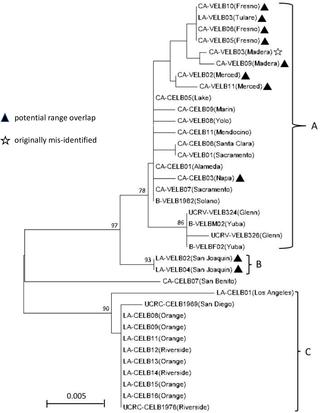Our official English website, www.x-mol.net, welcomes your
feedback! (Note: you will need to create a separate account there.)
Non-invasive genetic monitoring for the threatened valley elderberry longhorn beetle.
PLOS ONE ( IF 2.9 ) Pub Date : 2020-01-17 , DOI: 10.1371/journal.pone.0227333 Raman P Nagarajan 1 , Alisha Goodbla 1 , Emily Graves 2 , Melinda Baerwald 1 , Marcel Holyoak 2 , Andrea Schreier 1
PLOS ONE ( IF 2.9 ) Pub Date : 2020-01-17 , DOI: 10.1371/journal.pone.0227333 Raman P Nagarajan 1 , Alisha Goodbla 1 , Emily Graves 2 , Melinda Baerwald 1 , Marcel Holyoak 2 , Andrea Schreier 1
Affiliation

|
The valley elderberry longhorn beetle (VELB), Desmocerus californicus dimorphus (Coleoptera: Cerambycidae), is a federally threatened subspecies endemic to the Central Valley of California. The VELB range partially overlaps with that of its morphologically similar sister taxon, the California elderberry longhorn beetle (CELB), Desmocerus californicus californicus (Coleoptera: Cerambycidae). Current surveying methods are limited to visual identification of larval exit holes in the VELB/CELB host plant, elderberry (Sambucus spp.), into which larvae bore and excavate feeding galleries. Unbiased genetic approaches could provide a much-needed complementary approach that has more precision than relying on visual inspection of exit holes. In this study we developed a DNA sequencing-based method for indirect detection of VELB/CELB from frass (insect fecal matter), which can be easily and non-invasively collected from exit holes. Frass samples were collected from 37 locations and the 12S and 16S mitochondrial genes were partially sequenced using nested PCR amplification. Three frass-derived sequences showed 100% sequence identity to VELB/CELB barcode references from museum specimens sequenced for this study. Database queries of frass-derived sequences also revealed high similarity to common occupants of old VELB feeding galleries, including earwigs, flies, and other beetles. Overall, this non-invasive approach is a first step towards a genetic assay that could augment existing VELB monitoring and accurately discriminate between VELB, CELB, and other insects. Furthermore, a phylogenetic analysis of 12S and 16S data from museum specimens revealed evidence for the existence of a previously unrecognized, genetically distinct CELB subpopulation in southern California.
中文翻译:

对受威胁的山谷接骨木长角甲虫的无创遗传监测。
山谷接骨木长角甲虫(Desmocerus californicus dimorphus,鞘翅目:Cerambycidae)是受到联邦威胁的加利福尼亚中央谷地特有亚种。VELB范围与其形态相似的姐妹类群,即加利福尼亚接骨木长角甲虫(CELB),Desmocerus californicus californicus(鞘翅目:Cerambycidae)部分重叠。当前的调查方法仅限于肉眼识别VELB / CELB寄主植物接骨木(接骨木(Sambucus spp。))中的幼虫出口孔,幼虫钻入并挖掘出进料廊。无偏遗传方法可以提供急需的补充方法,该方法比依靠目视检查出口孔的精度更高。在这项研究中,我们开发了一种基于DNA测序的方法,可从fr(昆虫粪便)中间接检测VELB / CELB,该方法可轻松,无创地从出口孔中收集。从37个地点收集了Frass样品,并使用巢式PCR扩增对12S和16S线粒体基因进行了部分测序。从本研究测序的博物馆标本中,三个源自弗拉斯的序列显示与VELB / CELB条形码参考具有100%的序列同一性。对fras衍生序列的数据库查询还显示,与旧的VELB喂养画廊的常见住所高度相似,包括ear,苍蝇和其他甲虫。总体而言,这种非侵入性方法是迈向遗传测定的第一步,该测定可以增强现有的VELB监测并准确区分VELB,CELB和其他昆虫。此外,
更新日期:2020-01-21
中文翻译:

对受威胁的山谷接骨木长角甲虫的无创遗传监测。
山谷接骨木长角甲虫(Desmocerus californicus dimorphus,鞘翅目:Cerambycidae)是受到联邦威胁的加利福尼亚中央谷地特有亚种。VELB范围与其形态相似的姐妹类群,即加利福尼亚接骨木长角甲虫(CELB),Desmocerus californicus californicus(鞘翅目:Cerambycidae)部分重叠。当前的调查方法仅限于肉眼识别VELB / CELB寄主植物接骨木(接骨木(Sambucus spp。))中的幼虫出口孔,幼虫钻入并挖掘出进料廊。无偏遗传方法可以提供急需的补充方法,该方法比依靠目视检查出口孔的精度更高。在这项研究中,我们开发了一种基于DNA测序的方法,可从fr(昆虫粪便)中间接检测VELB / CELB,该方法可轻松,无创地从出口孔中收集。从37个地点收集了Frass样品,并使用巢式PCR扩增对12S和16S线粒体基因进行了部分测序。从本研究测序的博物馆标本中,三个源自弗拉斯的序列显示与VELB / CELB条形码参考具有100%的序列同一性。对fras衍生序列的数据库查询还显示,与旧的VELB喂养画廊的常见住所高度相似,包括ear,苍蝇和其他甲虫。总体而言,这种非侵入性方法是迈向遗传测定的第一步,该测定可以增强现有的VELB监测并准确区分VELB,CELB和其他昆虫。此外,











































 京公网安备 11010802027423号
京公网安备 11010802027423号